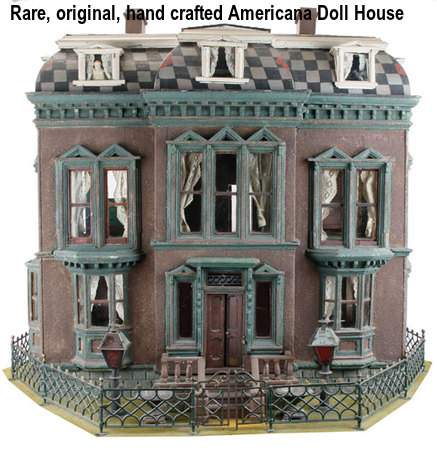




Hand-Made Wooden Dollhouses: What Makes Them So Special? ...By Doctor Know
I was never a person interested in dolls of any kind. Even action figures were off my radar screen as a kid. The G.I. Joes I received for Christmas one year ended up in the hands of my friends. I traded them for some Hot Wheels cars and a Man From U.N.C.L.E. undercover camera pistol. That Aquaman swimming action toy I was given for some long forgotten birthday ended up being traded for a Star Trek model (“Damn it Jim, I’m a Star Trek Fan, not a Super Friends or Justice League Member!”). Dollhouses fell into the same category for me.
Apart from the fact that I looked at dollhouses as a girl toy, I had no sisters and, therefore, no access to such things. To take it a step further, most of the friends I had who were girls were really tomboys and would rather play baseball and climb trees than play with dolls. Dollhouses and me were destined never to meet and it would have remained that way except for a fascination I developed for miniatures. It all began with a metallic western town and the death of a President.
I was in second grade attending school near where we lived on Long Island when the news of the assassination of President Kennedy came over the classroom loudspeaker. Since we were just minutes from lunch, the School Principal decided to allow everyone to go home early that day. Those who had to stay and wait for buses went to the cafeteria. I lived just a block from school and walked home with a bunch of my friends.
I found my mother and grandmother in a state of despair. It didn’t matter that they hadn’t voted for him and were of a different political persuasion. Our President had been murdered and that was reason enough to be upset, angry and sad. Coming from a generation without TV, they rarely watched. But that day it remained on non-stop.
As a reasonably intelligent kid I understood what had happened, but I didn’t know how to react to it. So I tried to stay quiet and out of the way. Nevertheless, my mother seemed to feel that I needed some sort of distraction. After picking up my father at the railroad station earlier than usual that day, they stopped and bought me a toy on the way back to our house.
My father arrived home very upset and gave me a hug as he walked in the door. My mother followed a few seconds later and handed me a cardboard box asking me to go play quietly for a while. I headed to my room and proceeded to examine the box. It had photos from Gunsmoke on it, so I assumed the toy was something related to the popular TV Show. Seeing the box was too deep for a board game, too wide to be a toy gun set and merely said ‘Old West’ in big letters on the cover, I couldn’t wait to see what was inside. But that meant cutting though the standard thick tape that protected all toy boxes from being opened in the store in those days. This was tape that I was certain had been designed to securely seal the vaults and protect the nation’s gold supply at Fort Knox.
After finally breaking through the box and Incredible Hulk-proof tape, I gazed at a miniature, metallic Old Western Town. It was already assembled for the most part and just required some unpacking. As a parent, I can only wish that today’s toy manufacturers would learn from that example. Everything I ever bought for my kids required the removal of at least one hundred plastic ties which are double knotted in both directions, 84 pages of instructions in eighteen languages (including Sanskrit), a dozen hours of assembly time, no tools (except the one I do not tend to have on hand) and thirty batteries.
I instinctively started role-playing with the plastic horses and figures included with the town. I imagined myself in a saloon fight. With great strength and conviction, I threw the card cheater out through a plate glass window and returned the money to all his victims. Then I was a lone Marshall facing down Desperados on the street while Chester came hobbling up behind me yelling, ‘Mr. Dillon, Mr Dillon!” Hiding in a small alleyway from the crooks trying to rob the town bank, I appeared out of nowhere and single handedly took them down saving the widow’s pension money and the mine’s payroll. Before I knew it, hours had gone by and I had become a fan of miniatures.
As birthdays and Christmases came and went, the Gunsmoke Old West Town was followed by an assortment of other miniature towns associated with various TV Shows including Mayberry from the Andy Griffith Show and Gotham City from Batman. One summer my father encouraged me to build a miniature town for our model railroad. I was thrilled! He purchased the supplies needed and I spent many enjoyable days gluing together the small structures and running the wires necessary for all the streetlamps and houses. I enjoyed building the town as much as playing with the trains.
Around 1970 our family moved from Long Island, New York to Saint Petersburg, Florida. My first exposure to a real dollhouse came a year later at the age of thirteen because of a glass of lemonade. I rode my bike for over five miles in the heat and humidity of an early Florida winter to get to a model-railroading museum. Once there, I was not amused to find that the place had nothing to offer thirsty guests coming in from the hot Florida sunshine but a decrepit drinking fountain with warm, bad tasting water. I would have gladly paid for a soda if the owners of the place had sense enough to have a vending machine available. They didn’t. Another disappointment came when I discovered that this once fabulous Shangri-La of model railroading had deteriorated to a point that it was merely an embarrassing shadow of what their colorful brochure promised. There were more lies told in that brochure than in a lawyer’s office.
The model-railroading museum had moved most of its contents from a large house to what looked like a big workshop in the backyard. That was necessitated by a leaky roof and some badly needed repairs to the house. The workshop had originally housed just the model railroad setup of Lionel, HO and various European brands of model trains. Combined, the tracks probably covered an eighth of a mile. It was impressive to look at, but of the five track setups, only one was operational when I visited.
While the static displays of antique model trains and a brief lecture on model railroading history had made my dreary bike ride and the bad water drinking fountain almost worth the trouble, I washed very upset that most of the railroad setups weren‘t working. That had been what I really come to see and experience. A tired looking volunteer dressed in a train engineer outfit that needed washing assured us that like the house, the model train setups were being fixed. Admission had been reduced to fifty cents during the planned construction. I hoped my half a buck would help with their much-needed repairs and left in search of a cold soda machine or any nearby convenience store I could find.
Sweaty, annoyed and wondering why I had bothered to come all this way, I unlocked my bike from the model railroad museum fence and started walking it out to the street. Passing the house next store, I noticed an elderly woman serving a group of people some very enticing ice-chilled Lemonade on the porch. A sign in the front yard revealed that the large house was also a museum. It was a re-creation of daily life in a country home from the nineteenth century. A couple of role playing volunteers who dressed in antique clothing and were old enough to be from the 1800s offered escorted tours for those who wanted more than just a walk thru.
For me, the cold lemonade and a chance to get in out of the sun for a few minutes was well worth the dollar donation being requested for entry. I deployed the kickstand of my bike, took a dollar out of my pocket and headed up to the porch. I was greeted by a warm smile and offered a cold glass of lemonade that tasted better than any beverage I have ever had before or since. The elderly woman even let me in for fifty cents because I was a student. “Be smart and stay in school.” There was no charge for the public service announcement she offered with the discount admission.
The elderly woman’s name was Roberta. I remember that because it was also the name of my best friend’s dog. Roberta (the volunteer, not the dog) proceeded to ask me if I wanted to join the escorted tour of the museum which was just starting. How could I refuse? The place seemed intriguing and there was the promise of more Lemonade at the end of the tour.
Like the model railroading debacle next door, this museum looked very much out of place. Both existed in old houses which became part of a suburban neighborhood that grew up around them sometime in the 1960’s. Despite the fact that they were off the beaten path and had outdated brochures, both places were kept going by a steady flow of visitors which came from school field trips and tour buses. A quick and inexpensive stop for tour bus operators, both museums offered winter visitors a bathroom break and about ninety minutes, collectively, worth of informative entertainment. Those half frozen bus tourists from the Midwest and Northeast were happy to see anything besides ice and snow.
The nineteenth century country living tour began in a huge back yard area which was a small working farm. They used only nineteenth century tools to get the job done. Agricultural Students from a local college donated their time to work the farm and gain some real hands-on experience with crops and farm animals. Only natural methods of pest and disease control were used. When crops grown on the premises went on sale a couple of times a year to help raise funds for the place, they sold out fast. People had just started to really appreciate the benefits of eating foods grown in a pesticide free environment during those days.
A small gift shop selling homemade jellies, jams and hand-dipped candles produced on the premises was popular with the tourists and locals alike. Also available were country style teas, coffees, biscuit tins, pancake mixes, small craft kits, dollhouse plans, wooden toys and miniatures that were hand-made on the premises. Sales of all that stuff helped to keep the place going. I did my part by purchasing a slingshot kit from the wooden toy counter so I could go home, put it together and shot the neighborhood girls in their behinds. That also made the trip worthwhile.
As the tour of the farmyard began, Roberta was joined by a man who was a retired Farmer. He had also been a teacher with several degrees in Agriculture. He ran that part of the museum and explained the vast differences between Nineteenth and Twentieth Century farming. I was amazed at how many pieces of machinery were unrecognizable to me as farm equipment. Given the lack of mechanical or powered equipment available to farmers a hundred years ago, I didn’t envy the work that the student volunteers had ahead of them. They had to guide heavy plows and walk behind beasts of burden as the farm animals pulled them through the field. That often meant stepping in big animal poop on a regular basis. I noticed that most of the students were smart enough to wear lightweight hiking boots or old shoes.
The next segment of the tour had us entering the back door of the country home where we stepped into a huge, seemingly ancient kitchen. The only objects familiar to me were a few pots, a sink and stove. I had no idea what most of the other kitchen implements had been used for. Roberta took the time to identify them for us. While listening to her, I noticed a few small chairs and a table built for children near a large fireplace in a back corner of the kitchen. I learned that these types of country kitchens often doubled as play areas and family rooms during chilly times of the year. Behind the children’s table and far off to the left of the now dormant fireplace stood a huge wooden dollhouse. I had never seen anything like it.
Unlike the small, cheap plastic and metal dollhouses mass-produced and marketed in chain stores, this one looked immense and was stunning in detail. Hand made sometime late in the last century, this dollhouse had aged well and been donated by a collector who once visited the museum and was impressed. It was obvious that the people who ran this place appreciated the gift and took great care to preserve it.
Despite the roughness of some of the furniture which had been hand carved and placed inside of the dollhouse, the detail of the miniature structure itself was amazing. I couldn’t get over it! It was as though someone had taken a real, full-sized home and shrunk it. The dollhouse was also surprisingly interactive. Roberta explained how various parts could easily be removed for play, put back in place for storage or opened up to expose whole sections of the structure despite its immense size.
As we moved on to a large front room, three more dollhouses were on display. These were spectacular and faithful recreations of large Victorian homes, but had been more recently built in the farm workshop from plans available for sale in the museum gift shop. Despite the quality of the workmanship, it was easy to see the difference between the handcrafted structure in the kitchen and the others built using power tools. Those differences became more obvious to me on the many subsequent trips that I made to the museum with my parents and by myself.
I became fascinated with the place and even did some volunteer work helping to paint and clean various parts of the country house and barn. I learned a lot just by listening to Roberta and the other volunteers. I wrote more than a few essays over the next few years in junior high and senior high school about what I learned at the museum about nineteenth century country living, farming and the hand-crafting of miniatures. My enthusiasm rubbed off and more than a few teachers and students also became interested in the museum as a result.
The country craft miniatures made and sold at the museum really got my attention. They had a craftsman who came to the place a few times a week during the winter months. His name was Frank and he made small wooden miniatures right there on the premises much to the delight of all the winter visitors. These were later sold in the gift shop and flew off the shelves. He split the profits with the museum and maintained a small workshop attached to one side of the country house.
I helped clean and sharpen some of Frank’s tools and swept up from time to time. I was fascinated by his ability to quickly create tiny furniture pieces with simple hand tools. The pieces he decided to paint were done with a few brush strokes and looked far superior to anything I had seen in a store or catalog. I wished that I had his talent or could learn his craft. Although my Grandfather on my mother’s side had been a Master Carpenter, I had absolutely no talent in that area. I failed woodshop miserably trying to make a kitchen knife rack that ended up looking like a big pile of misshapen, wooden crap. I did enjoy giving it a try.
Another one of the highlights from my experiences at the museum was helping a Volunteer named Jennie to make miniature recreations of farm animals. Casey was a second year Student at a local Veterinarian College and well known in the area as a talented maker of miniature wooden horses. Her miniatures had been featured in the town newspaper and on local television. Casey was crazy about horses! She had horse t-shirts, jeans with horse decals sewed and ironed on to them, and a jacket with a painting of her own horse on the back. If they were available in those days, I’m sure she would have been wearing panties with pictures of horses printed on them. Although she excelled at crafting miniature wooden cows, donkeys, pigs and chickens, her tiny horses were amazing little works of art.
Casey’s parents owned several horses and she had one herself. She called her horse Blaze after a Herman’s Hermits record album title with a horse photo on the cover. Having discovered a knack for crafting wooden figures while still very young, she was given her first set of hand tools at the age of nine. Casey once showed me a photo of her room. It was filled to overflowing with shelves and shelves of miniature wooden horse figures. Her parents encouraged her talents and that worked out because she hated household chores. She didn’t mind doing her part when it came to caring for the animals, but vacuuming and cleaning the bathroom weren’t things she would do without raising a major fuss. Casey told me that she would gladly clean every horse stall in her barn as long as she didn’t have to cook a meal or do laundry.
! Casey came to the museum about once or twice a month to make some horse miniatures. She donated profits from the sales of those miniatures in the gift shop to the care and feeding of the farm animals at the museum. Her parents had been patrons of the place for years and Casey wanted to follow in their footsteps. I was just fourteen at the time and all thumbs when it came to crafting anything more complicated than Play-Doe. I assisted her with paint preparation and cleanup duties. I didn’t mind that because Casey was a fascinating person to be around. I enjoyed hearing her horse stories and gained from the knowledge she had of miniatures and their value.
. As a result of my experiences at that Museum, I moved from being just entertained by the miniature toy towns I played with in my youth to being thoroughly fascinated with miniatures and wooden crafted items in general. Although I never became a serious collector myself, I rarely missed an opportunity to view small and often unique wooden miniature collections kept in tiny museums throughout the USA and Canada. I visited many such places while traveling around as a Professional Speaker. Along the way, I have learned a lot about these things and will share some of that with you.
Despite what the books say, no one really knows when or where miniatures were first created for enjoyment. Many ancient societies and civilizations were known to have had miniatures of deities, people, animals and things made for ceremonial use. The ancient Egyptians of the Old Kingdom buried miniatures of animals, slaves, boats, furniture and most everything they had used or come across in life with their dead. Oriental societies made miniature temples and statues. African tribes crafted tiny wooden huts, peopled them with stick figures in frightful looking headdresses and placed the small structures on tall wooden polls. The huts were supposed to scare off evil beings and the imagined threat of people who were able to turn into animals and kill their enemies.
Some of the first evidence of miniatures created for pure enjoyment appeared about four hundred years ago in Germany. Tiny rooms of miniature furniture were symbols of wealth and status because only the very wealthy could afford them. Kept in display cabinets where the miniatures was exhibited and separated into room settings, these cabinets soon became miniature homes called ‘baby houses’ and were owned and treasured by adults. Not considered toys, the miniatures and cabinets were kept out of the reach of children. These ’baby houses’ became the first dollhouses known to history. Miniature people and animals didn’t appear in these collections until later.
By the early 1800s, the display cabinets and ‘baby houses’ had changed. They were now scale models of complete homes, perfect in every detail with exteriors as finely crafted as the interiors. These early dollhouses became as valuable as the miniatures they displayed and were as expensive as the average full size house of the day. They were handcrafted heirlooms built by gifted craftsman, lavishly adorned with the finest fabrics and furnished with miniature copies of the best furniture and china sets. Purchased by the royalty, aristocracy and wealthy of Europe, they were presented to the teenage daughters of the privileged classes. As the wealth of Europe grew, the ages of presentation lowered until young children found themselves in possession of these handmade treasures.
Early American Settlers from Europe also fell in love with the idea of dollhouses, but few could afford the lavishly built German miniatures. As a result, wooden dollhouses became an ideal project for adults and the perfect gift for children who lived in the pre-industrial farming communities of America. While these miniatures may have seemed primitive when compared with finely crafted European dollhouses, they had a certain flare and portrayed a new country style which eventually became known as the ‘Americana’ or “Yankee’ genre.
The Americana style of hand-made wooden dollhouses became very important after the industrial revolution. As the idea of mass production took the world by storm, metal dollhouses and other miniatures were churned out by the thousands. Even wooden miniature structures were quickly assembled through factory mechanization and shoved onto store shelves at prices that almost everyone could afford. All this was good news for children who wanted inexpensive toys, but bad news for quality in the world of wooden miniatures.
Wood or Metal? That’s a question that Collectors of both types of dollhouses, miniatures and toys will always argue about. Some people love those mass produced metal monsters, while others crave the simplicity and craftsmanship of the classic wooden miniatures and dollhouses. If it’s about being a collectible, most metal miniature mass-produced houses made in America over 100 years ago are going for just $50-$150 today. Wooden dollhouses in the Americana style and hand-crafted in the USA from the same period can reach prices well into thousands of dollars, or even tens of thousands of dollars if they include miniature wooden furnishings from the same period. Handmade wooden dollhouses that come with their original furniture can see prices that reach the sky. That’s because there are so few available. Older, handcrafted European wooden miniature houses can reach hundreds of thousands of dollars (or much more) if you can find them. Even a good mass produced wooden dollhouse made in America today will cost $350-$600.
If you want something that the kids can play with and possibly keep as an heirloom, stay in the mass-produced range of $350-$600. If you want an investment that can be handled by responsible teens and adults, we’re talking Americana style wooden handcrafted dollhouses. Whether they are Country, Urban or Suburban in design, Americana style wooden handcrafted dollhouses will always be excellent long-term investments. That’s because fine quality models with handcrafted furniture can still be had for a reasonable $2000-$5000. Considering the hours that go into their creation and possible future value, these are a bargain. Why? Because there are less available every year.
In a society filled with people who want fast food, fast tans and fast crafts, hand-made wooden dollhouses are an endangered species. Handcrafted, wooden dollhouses made in the USA in the Americana or Yankee style are destined to be in very short supply as their makers pass on without a suitable number of replacements to meet the market’s demand. I’m sure they are out there, but I do not personally know anyone under the age of fifty-five who is handcrafting unique, Americana style doll houses here in America.
Beware of bargains. There are lots of people out there who have a knack for woodworking. They have access to home or commercial wood shops and can afford the few dollars it costs for a dollhouse kit at the local quick crafts store. These are not individually designed, handcrafted dollhouses. They are wooden ‘quickies’ which are often poorly glued and thrown together. Most will look good for a while, but are not made of quality materials. They will not last and can actually be worth far less than the average mass produced woodie after a couple of years. In terms of being collectable, they are not and many fall into the monetary value category of store bought wooden birdhouses. How can you tell the difference? The truth is on the outside and inside.
A quick trip to the Ebay Website will reveal a number of finished wooden dollhouse kits being sold as ‘originals’ or ‘collectables.’ These look identical because they are identical. They come from plans; patterns and kits mass-produced and sold in quickie craft stores. If you see more than one of the same designs being sold by difference sellers, watch out! They are probably kits or based on commercially available patterns. Many are off scale. Although there are differences between European and American Dollhouse scales, most of the cheap ‘woodies’ and knockoff dollhouses made from patterns and kits tend to be slightly smaller than the real thing. Some research into the complicated matter of wooden dollhouse scales can pay off for those wanting to purchase the real deal.
Taking a very close look at the interior of a dollhouse will often reveal its true value. The devil is in the details. Over-painting, under decoration, little attention to detail, sloppy window placement, poor workmanship and careless gluing are always signs that you’re buying an overpriced wooden ‘quickie’ that will not last or gain in value. It will not only lighten your wallet, but more importantly, buying that kind of junk will not help support the few real hand-crafters left out there or encourage new talent to join their ranks.
Handcrafted wooden Americana dollhouses are more than just collectible objects; they are individual works of art that embody the soul of a nation. While they tell the story of a simpler time, these miniatures also reveal the desire all Americans have to stand out from the rest of the world. We’re a nation that has created unique and lasting forms of art, music and culture. Americana-style, handcrafted wooden dollhouses can also be added to that impressive list.
(DOCTOR KNOW) Bill can be contacted on
FACEBOOK.
Back to DOCTOR KNOW









